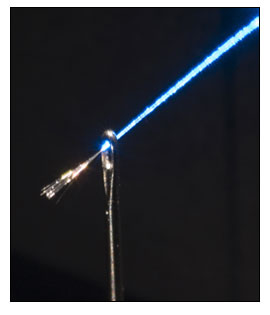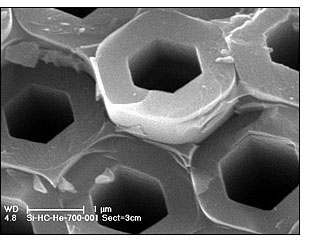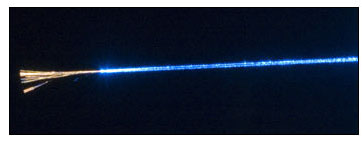UNIVERSITY PARK, Pa., March 20, 2006 -- Scientists from Pennsylvania State University and the University of Southampton in the UK have demonstrated a new way to combine microelectronics and optical fibers -- a development with potential applications in fields as diverse as medicine, computing and remote sensing. 
A wire-packed glass fiber passes through the eye of a needle. The glass fiber is glowing from blue laser light. Each of the semiconductor wires emanating from its end is just 2 micrometers in diameter -- 20 times narrower than a human hair. (Photo: Neil Baril, Penn State)
As they explain in the March 17 edition of the journal Science, they discovered how to fashion a thin, flexible tube of ultraclear glass -- an optical fiber -- that has a hollow core packed with microscopic wires made of a semiconductor such as germanium, then created solid-state electronic devices, including a transistor, inside the semiconductors.
"This advance is the basis for a technology that could build a large range of devices inside an optical fiber," said Penn State chemist John Badding, a lead author of the report.
Indeed, he said, it could help meet one of the greatest challenges in modern information technology. How do you rapidly and efficiently exchange information between optical fibers, which have proved to be the ideal medium for transmitting data (in the form of light pulses), and solid-state microelectronic devices, which are by far the most effective tools for manipulating and processing the data? 
Scanning electron micrograph (SEM) of the cross section of a partially silicon-filled holey fiber (Photo: Neil Baril, Penn State)
"If the signal never leaves the fiber, then it is faster, cheaper and more efficient," said Badding.
University of Southampton optoelectronics expert Pier Sazio, another lead author, said, "This fusion of two separate technologies opens the possibility of true optoelectronic devices that do not require conversion between optical and electronic signals. If you think of the fiber as a water main, this structure places the pumping station inside the pipe. The glass fiber provides the transmission and the semiconductor provides the function."
Optical fiber has proved to be the ideal medium for transmitting signals based on light, while crystalline semiconductors are the best way to manipulate electrons. One of the greatest current technological challenges is exchanging information between optics and electronics rapidly and efficiently. This new technique may provide the tools to cross the divide. 
This photo shows a glass fiber with a bundle of semiconductor wires emanating from it. (Photo: Neil Baril, Penn State)
Beyond telecommunications, optical fibers are used in a wide variety of technologies that employ light.
"For example, in endoscopic surgery, by building a laser inside the fiber you might be able to deliver a wavelength that could not otherwise be used," said Badding.
The key breakthrough was the ability to form crystalline semiconductors that nearly fill the entire inside diameter, or pore, of very narrow glass capillaries. These capillaries are optical fibers -- long, clear tubes that can carry light signals in many wavelengths simultaneously. When the tube is filled with a crystalline semiconductor, such as germanium, the semiconductor forms a wire inside the optical fiber. The combination of optical and electrical capabilities provides the platform for development of new optoelectronic devices.
The crystals were formed using chemical vapor deposition (CVD) to deposit germanium and other semiconductors inside the long, narrow pores of the hollow optical fiber. In the CVD process, a germanium compound is vaporized and then forced through the pores of the fiber at pressures as high as 1000 times atmospheric pressure and temperatures up to 500°C. A chemical reaction within the fiber allows germanium to coat the interior walls of the hollow fiber and then form crystals that grow inward.
"The process works so perfectly that you can get a germanium tube that has an opening in the center of only 25 nanometers through the length of the fiber," said Sazio. "This is only a tiny fraction of the diameter of the fiber pore, so it is essentially a wire."
This is the first demonstration of building crystalline structures, which are best for semiconductor devices, inside the pores of the capillaries.
The team has built a simple in-fiber transistor, and they point to the success of the erbium-doped fiber amplifier, which was invented at Southampton in the late 1980s, to illustrate the transformational possibilities of this technology. By incorporating the chemical element erbium into the fiber, the erbium amplifier allows efficient transmission of data signals in transoceanic optical fibers.
"Without that kind of device, it would be necessary to periodically convert the light to an electronic signal, amplify the signal, and convert it back to light, which is expensive and inefficient" said Sazio. "Since its inception, the erbium amplifier has made the Internet possible in its current form."
Beyond the simple devices that this research has demonstrated, the research team sees the potential for the embedded semiconductors to carry optoelectronic applications to the next level.
"At present, you still have electrical switching at both ends of the optical fiber," said Badding. "If we can get to the point where the signal never leaves the fiber, it will be faster and more efficient. If we can actually generate signals inside a fiber, a whole range of optoelectronic applications become possible."
Support for this research came from the National Science Foundation; the NSF-funded Penn State Center for Nanoscale Science; the Penn State-Lehigh Center for Optical Technologies; the UK Engineering and Physical Sciences Research Council; and the Mexican Council for Science and Technology.
For more information, visit: www.science.psu.edu/